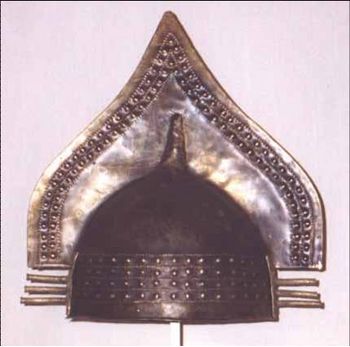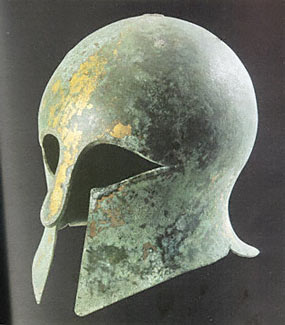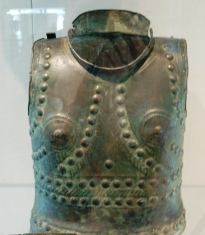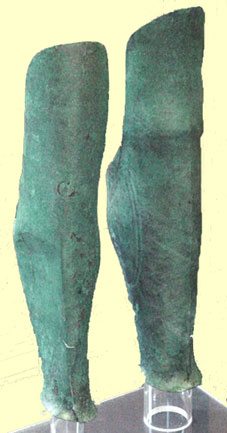

Etruria was the dominant culture in central Italy in 650BC and ruled over Rome from its founding to 509 BC, when the last Etruscan King was removed from power in Rome and the Roman Republic was established. The Etruscans are descendants of the Villanovans, who existed in northern Italy from approximately 1100-700 BC. The Villanovans are believed to be descendants of Danubian, and are closely related to the Hallstatt culture of the eastern Alps.
The Etruscan armor design was either inherited from their ancestor, the Villanovans, or borrowed from the long and influential Greek civilization. That is the reason why all their armors are similar to those of the two civilizations mentioned above. The material of choice for their armors was bronze and not iron because a proper and cheap way of processing iron was not yet found.
HELMETS |
|
Name: Villanovan helmet. Origin: 8-6th century BC. Excavated near the town of Bologna, Italy. Formed by joining together two pieces of bronze, each shaped to fit half the side of an individual’s head, along the crest of the helmets. They were most likely custom made, so no dimensions were given regarding this helmets. |
|
Name: calotte or “bell” helmet. Origin: 7th century BC. Excavated in Esquiline tombs located near Rome. The helmets found were dated to the labeled date of origin. Being the simplest of design it existed well before period of antiquity, and its origin has not been traced to any specific civilization. The definition of calotte is a skull-cap, which gives the proper description of this helmet. the average thickness for helmets of this period to be about 2.5 mm. |
|
Name: Etruscan Greek style bronze helmet. Origin: 7th century BC. Greek civilization design. This helmet can be recognized as borrowed from the Corinthian type helmet in ancient Greece. The import of the Greek style helmet into Etruria can be seen possibly as the result of the expansion of the Greek civilization over the sea to the south territory of Etruria in 8th century BC. |
|
CUIRASS |
|
Name: No unique name. Etruscan bronze cuirass. Origin: 7-6th century BC. 2 solid pieces connected by hinges at the hips and on either side of the necks. Following the human physiology, the bronze plates are designed to look like the chest and the back of a man. The protruding dots over the cuirass are a form of decoration passed down from the Villanovan civilization. |
|
GREAVES |
|
Name: No unique name. Etruscan greave. Origin: 600BC. Greek civilization design. The specific greave is currently located in the Vatican Museum in Rome. The greaves are made in the shape of the knee and shin. The green color illustrates that the piece was made of bronze which turns green as it is corroded by air. |
|


Integrative Materials Design Center - Worcester Polytechnic Institute




